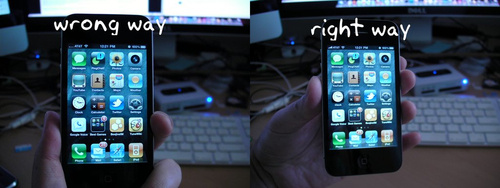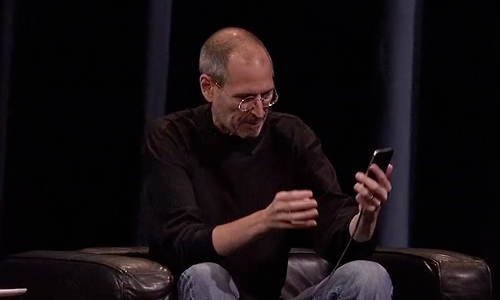Yesterday we reported that early iPhone 4 owners were seeing screen discoloration, as well as reception issues if they covered the antenna notch on the lower-left corner of the phone. Apple responded to the reception trouble today, and it turns out the company is well aware of it, according to Engadget. The company’s stance on the issue can be summed up by an email from Steve Jobs: “Just avoid holding it that way.”
The official response is of course a little more sensitive:
Gripping any mobile phone will result in some attenuation of its antenna performance, with certain places being worse than others depending on the placement of the antennas. This is a fact of life for every wireless phone. If you ever experience this on your iPhone 4, avoid gripping it in the lower left corner in a way that covers both sides of the black strip in the metal band, or simply use one of many available cases.
Few companies would blame their customers for a known issue with their product, but it looks like that’s what Apple is doing here. I’d be somewhat more sympathetic if Apple just admitted to the issue, but the tone of its response, particularly in Jobs’ email, is akin to a Jedi mind trick trying to convince us nothing is wrong.
It also makes the timing of Apple’s bumper case somewhat suspicious. In addition to helping protect your iPhone from falls, the bumper case also completely prevents you from holding your iPhone in a “bad” way.
It may not be entirely Apple’s fault, according to a blog post by Spencer Webb of the antenna design and consulting firm AntennaSys. Apparently, the FCC doesn’t account for hand placement when testing cellphone energy emissions, instead they just test for head placement. Consequently, all modern cellphones now have their cellular antenna located on the bottom — the furthest portion of the phone away from the head in typical usage. Similarly, AT&T doesn’t account for hand placement in its reception efficiency tests.
So when it comes to the iPhone 4, Apple was forced to ship with the current antenna design:
The antenna structure for the cell phone [iPhone 4] is still down at the bottom (I won’t address the WiFi nor GPS antennas in this blog entry). The iPhone 4 has two symmetrical slots in the stainless frame. If you short these slots, or cover them with your hand, the antenna performance will suffer (see this video I found on YouTube). There is no way around this, it’s a design compromise that is forced by the requirements of the FCC, AT&T, Apple’s marketing department and Apple’s industrial designers, to name a few.
In my two days with the phone thus far, I have been able to replicate the reception dropping issue by blocking my antenna band. But to do so, I had to hold the phone in a very unnatural way. I haven’t had any issues with my reception dropping suddenly in normal usage, and in fact my dropped call rate is much lower now than with my iPhone 3G S. Left-handed folks, on the other hand, may have a lot more trouble with this particular quirk.
Apple’s advice is sound, even if its tone is a bit defensive. If you’re experiencing the issue, get a case that can help prevent you from blocking the antenna. And if you’re still mad at Apple, simply don’t buy one of its bump cases. There are still many third parties making quality iPhone cases at prices much lower than $30.
Below, an image of Jobs himself holding the iPhone 4 wrong from the “Just Avoid Holding It That Way” Tumblr blog:
[Top image from Wasabimon via Gizmodo]
Don’t miss MobileBeat 2010, VentureBeat’s conference on the future of mobile. The theme: “The year of the superphone and who will profit.” Now expanded to two days, MobileBeat 2010 will take place on July 12-13 at The Palace Hotel in San Francisco. Register now. Tickets are going quickly. For complete conference details, or to apply for the MobileBeat Startup Competition, click here.



